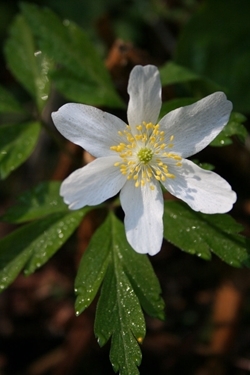Wood anemone
 Those who know me well will know that my absolute favourite flower is the wood anemone (Anemone nemorosa). To me, it is one of the signs that spring is finally here, and the woodlands are on the edge of a massive transformation!
Those who know me well will know that my absolute favourite flower is the wood anemone (Anemone nemorosa). To me, it is one of the signs that spring is finally here, and the woodlands are on the edge of a massive transformation!
The wood anemone is one of the first blooms of spring, which look like stars that have been throw out into the brown, dormant woodland floor, which is just about to wake up. They take advantage of the light available through the leafless canopy in a broadleaf woodland at this time of year, and as an indicator species of ancient woodlands, it could be a sign that you are stood in an irreplaceable habitat, an ancient woodland that has been continuously covered since the 1600s in England. They are a very slow-spreading species, which only extend six feet per hundred years, hence being an indicator of ancient woodland – they rely on the growth of their root structure rather than the spread of its seed.
So, what does a wood anemone look like, I hear you ask! They are a solitary white star-like flower with 5-8 petals, with a slight pinkish tinge underneath. They have a long-stalked stem; green leaves divided into three lobes, with each lobe divided; and the leaves are basal, meaning that they are in a rosette at the base of the plant.
While it is often found in ancient woodlands, it also grows in old hedgerows and shaded banks, and in the Yorkshire Dales it is frequently found in limestone pavements or even in areas that were once wooded but are now sadly lost.
As with many plants, I like to know more about folklore or myths that surround them, so this one is no exception. In fact, it is one that has a lot associated to it – so much so I can only write a fraction of what is attached to this flower.
To start with, the wood anemone has another name: the windflower. In Greek mythology, Anemone (daughter of the wind) was a nymph beloved by Zephyr. He was one of the four Anemoi, who were wind gods that represented the cardinal points of the compass, and Zephyr represented the west. Zephyr was more than just a wind god to the Greeks; he represented the wind of the west that gently blew, marking the end of the winter and the beginning of spring. When the wife of Zephyr found out about the romantic encounter, she banished the nymph from her court and transformed her into a flower bearing the name Anemone.
In other Greek mythology, anemones sprang out of the tears of Aphrodite while she was mourning the death of her lover, Adonis. Adonis was killed by the gods due to their jealousy over his love affair with the beautiful goddess of love.
The wood anemone carries a mix of good and bad omens. The Ancient Egyptians believed that the anemone plant contaminated the air and associated it with illness, and in China it is symbol of both healing and death. However, the Romans considered wood anemones a lucky charm and would pick the first flowers to appear each year to ward off fever.
The wood anemone also has a few vernacular names, as I mentioned – the windflower, but also an old local name like 'smell foxes' due to its musky smell, 'grandmother’s nightcap', and 'moggie nightgown'. The latter is used in parts of Derbyshire where 'moggie' can mean mouse, not cat.
This is the prime time to see these magical white star-like flowers, so why not go to for walk, where public access allows, and enjoy this wonderful spring spectacular.
Megan Lock
Advisory